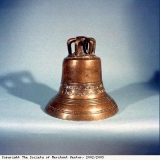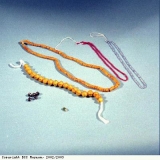‘Tradeing on ye coast of Africa’
Goods from Africa had made their way to Europe from at least the 3rd century AD. Gold was the main product that came to Europe. It was traded from West Africa through North Africa, to Europe, by Muslim traders from North Africa. European merchants began trading directly with West Africa in about the late 14th or 15th century. Traders from Bristol were amongst the Europeans who made the long voyage to the west coast of Africa with their goods. Items such as cloth, beads, brass kettles, and guns made up part of the cargo on board their ships. The goods were a mixture of items that were produced at home and items that were bought elsewhere. Europeans were using their goods to buy mainly gold, spices and ivory from the West African traders. Pictured here are some glass beads bought from manufacturers in Italy to trade with Africa. The beads were popular as glassmaking was uncommon in Africa, making them unusual and precious. They came in a variety of sizes, colours and shapes.
Later in the 16th century the Europeans started trading for different goods: enslaved people. The Europeans were colonising the world and taking countries as their own. They were using the natural resources in their colonies to make money. For example, the British-owned islands in the Caribbean, had good land for growing crops such as sugar. The Europeans needed a reliable labour force. So when they realised that they could purchase enslaved Africans from the traders in West Africa, they did so.




